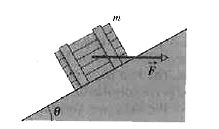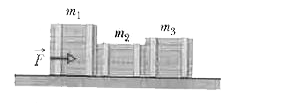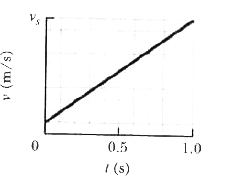A food shipper pushes a wood crate of cabbage heads (total mass m=14kg) across a concrete floor with a constant horizontal force →F of magnitude 40 N. In a straight-line displacement of magnitude d=0.50, the speed of the create decreases from v0=0.60m/s to v=0.20m/s.
(b) What is the increase ΔEth in the thermal energy of hte crate and floor?
To find the increase in thermal energy ΔEth of the crate and floor, we can follow these steps:
Step 1: Calculate the Work Done by the Applied Force
The work done by the applied force F can be calculated using the formula:
W=F⋅d
Where:
- F=40N (the force applied)
- d=0.50m (the displacement)
Substituting the values:
W=40N×0.50m=20J
Step 2: Calculate the Change in Kinetic Energy
The change in kinetic energy ΔK can be calculated using the formula:
ΔK=12mv2−12mv20
Where:
- m=14kg (mass of the crate)
- v0=0.60m/s (initial velocity)
- v=0.20m/s (final velocity)
Calculating the initial and final kinetic energies:
ΔK=12×14×(0.20)2−12×14×(0.60)2
Calculating each term:
ΔK=12×14×0.04−12×14×0.36
=0.28−2.52=−2.24J
Step 3: Calculate the Increase in Thermal Energy
The increase in thermal energy ΔEth is equal to the work done by the applied force minus the change in kinetic energy:
ΔEth=W−ΔK
Substituting the values:
ΔEth=20J−(−2.24J)=20J+2.24J=22.24J
Final Answer
The increase in thermal energy ΔEth is approximately:
ΔEth≈22.24J
The work done by the applied force F can be calculated using the formula:
W=F⋅d
Where:
- F=40N (the force applied)
- d=0.50m (the displacement)
W=40N×0.50m=20J
The change in kinetic energy ΔK can be calculated using the formula:
ΔK=12mv2−12mv20
Where:
- m=14kg (mass of the crate)
- v0=0.60m/s (initial velocity)
- v=0.20m/s (final velocity)
ΔK=12×14×(0.20)2−12×14×(0.60)2
Calculating each term:
ΔK=12×14×0.04−12×14×0.36
=0.28−2.52=−2.24J
The increase in thermal energy ΔEth is equal to the work done by the applied force minus the change in kinetic energy:
ΔEth=W−ΔK
Substituting the values:
ΔEth=20J−(−2.24J)=20J+2.24J=22.24J
The increase in thermal energy ΔEth is approximately:
ΔEth≈22.24J
Topper's Solved these Questions
- WORK, POWER, AND ENERGYBOOK - RESNICK AND HALLIDAYCHAPTER - WORK, POWER, AND ENERGYEXERCISE - CHECKPOINT
6 Videos
- WORK, POWER, AND ENERGYBOOK - RESNICK AND HALLIDAYCHAPTER - WORK, POWER, AND ENERGYEXERCISE - PROBLEMS
58 Videos
- WAVES-IBOOK - RESNICK AND HALLIDAYCHAPTER - WAVES-IEXERCISE - Practice Questions (Integer Type)
4 Videos
Similar Questions
A food shipper pushes a wood crate of cabbage heads (total mass m=14kg) across a concrete floor with a constant horizontal force →F of magnitude 40 N. In a straight-line displacement of magnitude d=0.50, the speed of the create decreases from v0=0.60m/s to v=0.20m/s.
How much work is done by force →F, and on what system does it do the work?
View SolutionA horizontal force of magnitude 41.0 N pushes a block of mass 4.00 kg across a floor where the coefficient of kinetic friction is 0.600. (a) How much work is done by that applied force on the block-floor system when the block slides through a displacement of 2.00 m across the floor ? (b) During that displacement, the thermal energy of the block increases by 40.0 J. What is the increase in thermal energy of the floor ? (c) What is the increase in the kinetic energy of the block ?
View Solution
Knowledge Check
A man pushes a 80 N crate a distance of 5.0 m upward along a frictionless slope that makes an angle of 30∘ with the horizontal. The force he exerts is parallel to the slope. If the speed of the crate increases at a rate of 1.5 then the work done by the man is :
A−200JB61 JC140 JD260 JA particle of mass 2kg travels along a straight line with velocity v=a√x, where a is a constant. The work done by net force during the displacement of particle from x=0 to x=4m is
Aa2B2a2C4a2D√2a2
In Fig. 5-45, a crate of mass m = 115 kg is pushed at constant speed up a frictionless ramp (θ=30.0∘) by a horizontal force →F. What are the magnitudes of (a) →F and (b) the force on the crate from the ramp ?

View SolutionFigure 6-47 shows three crates being pushed over a concrete floor by a horizontal force F of magnitude 425 N. The masses of the crates are m1=30.0kg,m2=10.0kg,andm3=20.0kg The coefficient of kinetic friction between the floor and each of the crates is 0.700. (a) What is the magnitude F32 of the force on crate 3 from crate 2? (b) If the crates then slide onto a polished floor, where the coefficient of kinetic friction is less than 0.700, is magnitude F32 more than, less than, or the same as it was when the coefficient was 0.700?

View SolutionA worker pushed a 23 kg block 8.4 m along a level floor at constant speed with a force directed 32∘ below the horizontal . If the coefficient of kinetic friction between block and floor was 0.20, what were (a) the work done by the worker's force and (b) the increase in thermal energy of the block-floor system ?
View SolutionHere we calculate on instantaneous work - that is, the rate at which work is being done at any given instant rather than averaged over a time interval. Figure 8-34 shows constant forces →F1 and →F2 acting on a box as the box slides rightward across a frictionless floor. Force →F1 is horizontal , with magnitude 2.0 N, force →F2 is angled upward by 60∘ to the floor and has magnitude 4.0 N. The speed v of the box at a certain instant is 3.0 m/s. What is the power due to each force acting on the box at that instant, and what is the net power? Is the net power changing at that instant?
View SolutionA 68 kg crate is dragged across a floor by pulling on a rope attached to the crate and inclined 15∘ above the horizontal.
(a) If the coefficient of static friction is 0.50, what minimum force magnitude is required from the rope to start the crate moving?
(b) If μk=0.35, what is the magnitude of the initial acceleration of the crate?
View SolutionA 4.10 kg block is pushed along a floor by a constant applied force that is horizontal and has a magnitude of 50.0 N. Figure 6-46 gives the block's speed v versus time t as the block moves 0.5 1.0 along an x axis on the floor. The scale of the figure's vertical axis is set by vs=5.0 m/s. What is the coefficient of kinetic friction between the block and the floor?

View Solution
